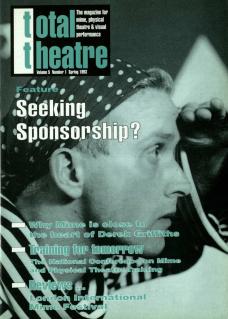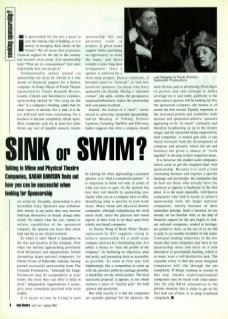Is sponsorship for the arts a quest to save the sinking ship of funding, or is it merely rearranging deck chairs on the Titanic? We all know that at present, financial support for the arts in this country has reached crisis point. Can sponsorship help? What are its consequences? And most importantly, how can we get it?
Fundamentally, money gained via sponsorship can never be viewed as a sole means of financial support for a theatre company. As Penny Mayes of Trestle Theatre (sponsored by Turner Kenneth Brown, Isopon, Citroen and Sainsburys) explains, sponsorship should be ‘the icing on the cake’ to a company’s funding, rather than its main source of income. For a start, it is far too difficult and time consuming for a business to become completely reliant upon. Most companies wait for at least two years before any sort of tangible monetary results are achieved. Secondly, sponsorship is also incredibly risky. Sponsors may withdraw their money at any point: they may become bankrupt themselves or simply change their minds. No matter what the size, stature or artistic capabilities of the sponsored company, the sponsor can leave their client high and dry at any chosen moment.
So where to start? Much is dependent on the size and location of the company. First steps can include approaching prominent local businesses and organisations, before attempting larger national companies. As Denise Evans of Kaboodle explains, having gained successful sponsorship from The Granada Foundation, ‘although the larger businesses may be sympathetic to your needs, the most they can offer is help in kind’. Independent organisations it seems give more immediate practical help more readily.
It is easier to start by trying to gain sponsorship for one particular event or project. It gives some support whilst providing an opportunity to learn the ropes, and move towards a more long-term arrangement. Once a sponsor is achieved for a short-term project, Denise continues, it becomes easier to ‘network’, to find new potential sponsors via those who have sponsored you already. Having a ‘personal contact’ she adds, within the prospective organisation/business, makes the sponsorship deal a lot easier to clinch.
Indeed, the notion of a ‘deal’ seems crucial in achieving successful sponsorship. Adrian Mealing of Talking Pictures (sponsors including NatWest and Helvetica banks) suggests that what a company should be looking for when approaching a potential sponsor, is to ‘find a commercial partner’. It is important to think not only in terms of what you have to gain via the sponsor but how they will benefit by sponsoring you: clarify what you as a company have to offer, identifying what is specific to your work alone. Many mime and physical theatre companies, although underplaying the word mime itself, stress the physical and visual aspects of their work to set them apart from wholly text-based companies.
As Denise Wong of Black Mime Theatre (sponsored by BT) suggests, trying to achieve sponsorship for a small-scale company need not be a humiliating time. It is rather, a chance to ‘raise the profile of the company’, by furthering its objectives, aims and goals, and presenting them as accessibly as possible. So what at first may feel frighteningly like a competition to come up with the glossiest publicity package possible, is thankfully not the whole picture. The most successful proposal, it appears, is one which outlines a sense of ‘mutual gain’ for both sponsor and sponsored.
But what exactly is it that the companies are mutually gaining? For the sponsors, the most obvious gain is advertising. From logos on posters and vans through to media coverage on TV and radio, publicity is the main return a sponsor will be looking for. For the sponsored company, the money is of course the best reward. Equally important is the increased profile and credibility both sponsor and sponsored achieve: sponsors appearing to be ‘in touch’ culturally and therefore heightening an up-to-the-minute image, and the sponsored being supported by such companies. A mutual gain deal is one which forwards both the development of company and sponsor, where the art and business are given a chance to ‘work together’ to develop in their respective areas.
It is, however, the smaller scale companies which seem to get the roughest deal with sponsorship. Because it is such a time consuming business and requires a specific language and knowledge, the companies that do best are those who already have the resources to appoint a fundraiser in the first place. It is the more reputable, well-known companies who find it easier to achieve sponsorship from the larger national companies, merely because of their immediate prestige. Such a situation we are already far too familiar with; as the ship of financial support for the arts begins to sink, our national companies, soaked in heritage, are guided to shore, as the rest of us are left to gulp in yet another mouthful of salt water. Continual funding reductions in the arts means that some companies may have to see sponsorship more and more as a sole alternative to government funding, which is in many ways a self-destructive task. The constant worry is that the more marginal companies will slip through the net completely. If things continue to worsen in this way, smaller scale/experimental companies may be faced with what seems like the only real alternative to the present situation – that is either to get on the first boat out of here, or to jump overboard completely.

